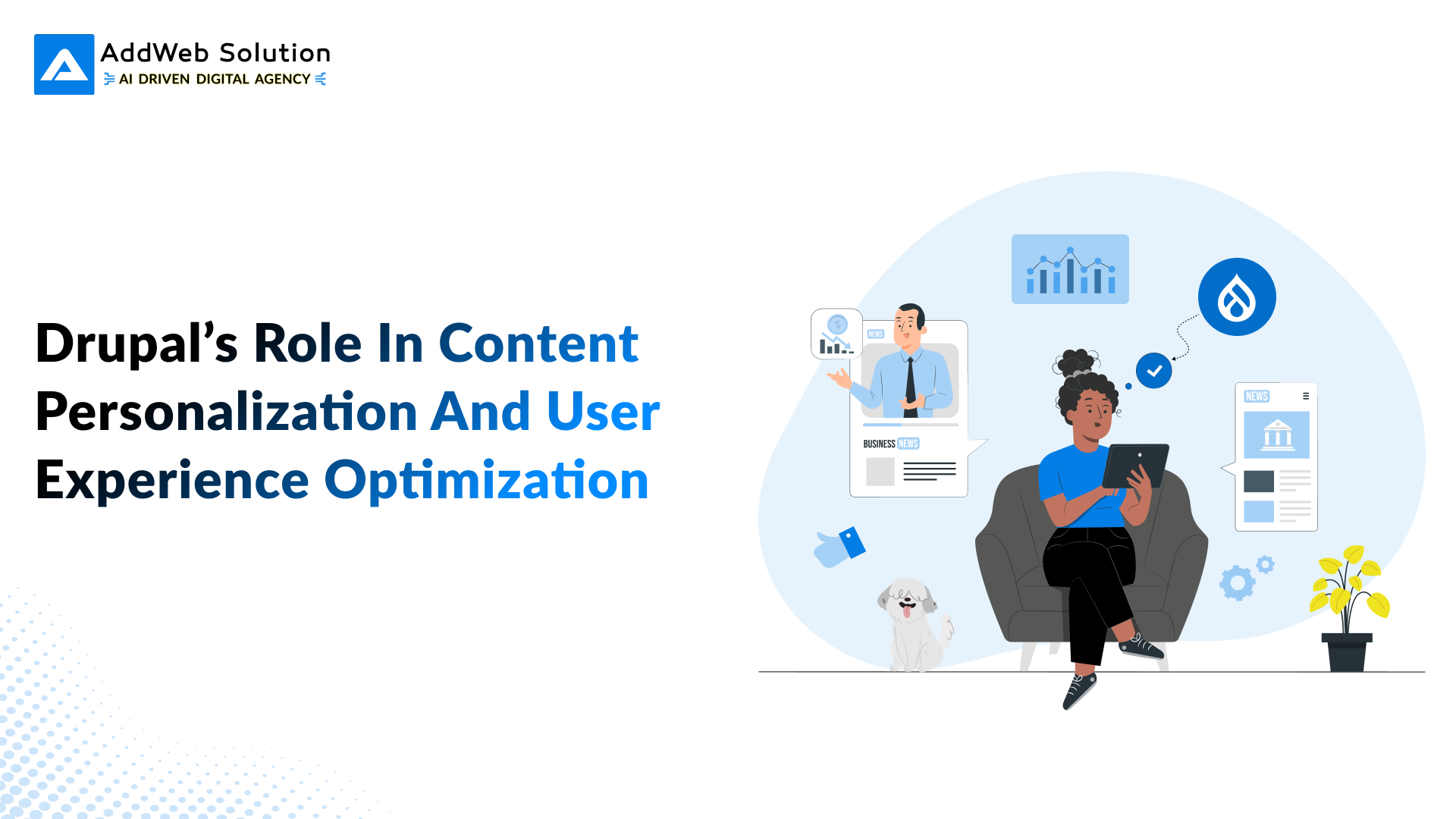In a world full of choices in the digital space, users no longer simply browse—they want to be understood. When shopping, learning, or reading online, they demand customized experiences that cater to their needs.
One-size-fits-all content is no longer sufficient; personalization is now the minimum requirement. Companies that fail to keep up with this expectation are at risk of losing their relevance in an ever-changing digital landscape.
This is where Drupal makes its mark. Outside of an ordinary CMS, Drupal is a solid digital experience platform that empowers organizations to build personalized, intuitive, and high-performing user experiences.
With its solid architecture and extensive ecosystem of modules, Drupal enables brands to create digital experiences that are personal and seamless, boosting engagement, retention, and conversions.
Let’s explore how Drupal excels in providing personalized content and streamlining user experiences across industries.
Key Features of Drupal for Content Personalization and UX Optimization
Drupal provides strong functionality to deliver personalized and frictionless user experiences. Being highly flexible in content architecture and adding advanced personalization capabilities, Drupal makes each user interaction relevant and compelling.
1. Granular User Segmentation for Personalized Experiences
Drupal allows businesses to segment their audience into specific user groups depending on behaviors, geolocation, roles, devices, and browsing history. This high-granularity segmentation will enable marketers to present content based on a user’s intent or interest in real-time.
For example, a return visitor can be welcomed with content personalized from their previous interactions, while a new visitor can be presented with welcome incentives or tutorials. Such dynamic personalization generates higher engagement and relevance from the very first click.
2. Structured Content Architecture that Powers Relevance
One of the underlying strengths of Drupal is its ability to manage structured content with pliable content types, taxonomies, and entity references. This structure allows site administrators to characterize accurately and associate content, making it easier to deliver contextualized experiences.
Through intelligent content categorization, Drupal shows users what’s suitable for them—whether a product recommendation, a weblog, or a call-to-action, depending on their path. This architecture enhances personalization and simplifies content creators’ backend workflows.
3. Personalization Tools that Bring Intelligent Interactions
Drupal’s ecosystem features a collection of personalization modules and tools that can be used to turn static pages into dynamic ones. Modules enable real-time, dynamic content updates based on context, such as the user’s browser type, referrer, or session information.
From a business perspective, software takes it a step further, using machine learning to offer AI-based recommendations. These kinds of tools allow for personalization of design and content, and companies can create experiences that evolve based on a user’s behavior over time.
4. Seamless Integrations for Data-Driven Personalization
Effective personalization relies heavily on user data, and Drupal is integrable. It integrates perfectly with CRMs like Salesforce, marketing automation tools like Marketo and HubSpot, and analytics tools like Google Analytics.
Integrations help businesses to capture, analyze, and act on data at various touchpoints, delivering consistent and personalized experiences across channels. Drupal offers a single customer view, helping brands make informed decisions by using real-world behavior and feedback.
5. Data Privacy and Consent Management
Personalization must exist together with privacy. Drupal supports GDPR readiness and other data protection regulations with modules like EU Cookie Compliance and integrations with third-party consent management platforms.
These allow businesses to collect user data responsibly and transparently, and offer personalized experiences with trust.
6. Headless Drupal for Real-Time, Frontend Personalization
Drupal’s decoupled (headless) architecture allows it to be utilized as a backend content engine for frontend frameworks like React, Vue, or Angular.
This allows lightning-fast, real-time personalization on the frontend, where user actions can dynamically trigger content updates. Decoupled Drupal is most suitable for the high-performance and high-fidelity needs of companies like e-commerce or media websites.
7. Multilingual and Multisite Capabilities for Global Reach
For global companies, Drupal’s built-in multisite and multilingual features are a game-changer. It enables organizations to deliver region-specific content, languages, and user experience from one backend.
Whether localizing content across European markets or ensuring brand consistency on dozens of regional sites, Drupal makes complexity simple. This capability not only enhances personalization but also strengthens brand identity across geographic and cultural divides.
8. Responsive Design of a Seamless User Experience
Users these days toggle between devices—mobile, tablet, desktop—expecting the same experience across them. Drupal’s theming layer supports responsive design, which works well across different screen sizes and platforms.
From a product page to a blog post, Drupal renders layout and content flow frictionlessly. It lowers rates and reduces the friction. A device-agnostic approach is essential for delivering the best UX in an era where mobile is the primary priority.
9. Performance Optimization for Faster Experiences
Slowness is a quiet breakup in user experience. Users get frustrated and abandon sessions when a site loads slowly. Drupal addresses this with built-in performance features, such as page caching, dynamic content caching, and integration with third-party products like Varnish and content delivery networks (CDNs).
With these, your site is bound to be fast even when heavily visited. Maximized performance not only improves user satisfaction but also contributes to increased SEO rankings and improved engagement metrics.
10. Accessible Support for All Users
A fully optimized user experience engages everyone. Drupal is committed to web accessibility and natively supports WCAG and ADA standards. Its core features are semantic HTML, keyboard navigation, ARIA attributes, and assistive technologies.
All of these make Drupal sites usable by people with visual, auditory, and cognitive disabilities. When your web platform is accessible, you not only increase your audience but also demonstrate your brand’s social responsibility and inclusivity.
11. Editorial Agility for Real-Time Personalization
In addition to technical capability, Drupal provides content teams with editorial tools that make personalization flexible and manageable. Through custom workflows, scheduling of content, revision history, and inline editing, marketing teams can quickly modify content based on trends or user data.
From rolling out a regional campaign to A/B testing different headlines or seasonal offers, Drupal allows for changes to go live without developers. This responsiveness helps businesses stay contemporary and up-to-date in an ever-changing digital landscape.
12. AI and Future-Ready Personalization
Drupal isn’t resting—it’s entering the future with AI-fueled personalization and predictive analytics. Connections to Acquia CDP and third-party AI systems enable more intelligent content targeting, user intent prediction, and real-time personalization.
From chatbots that guide users or content blocks that automatically adjust according to mood or sentiment, Drupal is paving the way for next-generation experiences. This visionary approach means your platform is evolving along with user expectations.
13. A/B Testing and Feedback Tools for UX
Drupal supports integrations with A/B testing tools, such as Google Optimize, VWO, and Hotjar. These tools allow businesses to test different designs and content strategies to determine what works best for their users. The feedback received is used to improve the user experience and continually enhance the UX.
14. Real-World Use Cases: Drupal in Action
eCommerce: Delighting with location-based promotions and product recommendations based on browsing activity and purchase history.
Education: Tailoring course recommendations, application procedures, and course materials for prospective students by interest or geography.
Healthcare: Delivering individualized streams of content by patient type (new vs return), selected symptoms, or health profile.
Conclusion
In a world where users are bombarded with content every second, the ability to offer personalized, meaningful, and intuitive experiences is what sets a brand apart.
Drupal equips businesses with the tools not just to manage content, but to craft experiences that speak directly to individual users. From its robust segmentation features and intelligent modules to its responsive design, privacy-first architecture, and accessibility standards, Drupal serves as a full-scale engine for content personalization and UX excellence.
If you’re looking to build digital experiences that are both engaging and strategic, Drupal is the platform that empowers you to deliver on that vision. At AddWeb Solution, we specialize in leveraging Drupal to its full potential—crafting customized, high-performance websites that resonate with your users and drive business success. Let’s build experiences that matter, together.
FAQs
- How does Drupal personalize content for users?
Drupal uses user segmentation, contextual modules, and AI-based tools to serve personalized content in real-time. - Can Drupal personalization work without Acquia tools?
Yes. While Acquia enhances Drupal’s capabilities, open-source modules like Smart Content and third-party APIs can also deliver powerful personalization. - Is Drupal suitable for large enterprises with global audiences?
Absolutely. Drupal’s multisite, multilingual, and integration-ready architecture makes it ideal for enterprise-grade personalization across regions.

Get Started with Custom AI Solutions Today!

Pooja Upadhyay
Director Of People Operations & Client Relations

